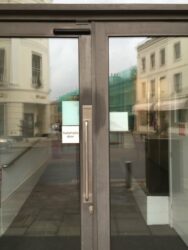
Aluminium Commercial Doors are the correct product to install in any retail or high traffic environment. This is because the doors themselves and the hardware used on commercial doors has been tested and designed to ensure that it continues to perform despite the many people that can pass through a door installed in a shop or school in any given day.
One item of door hardware that is subjected to heavy usage are the door handles. Particularly with door pull handles these are obviously the first point of contact for anyone about to push or pull open a door. However it is important that door handles are the correct sort and fit for purpose.
What are the common types of handles for commercial doors?
Pull handles for doors come in many different types such as straight, cranked, pole handles, D handles, offset handles and many others. The variety of handles available is there to ensure that whether you desire a glazed or panelled door, a timber or metal door, there is a handle to suit it.
Typically these handles feature single side fixings where there is a handle on the one side only or back to back fixings where there are handles on both sides of a door. Door handle fixings will depend upon the door they are being fixed to and when ordered are requested with either fixings for solid, hollow or metal doors.
Door handles are generally designed as universal handles to suit all types of doors rather than one particular system.
The door stile affects the type of handle chosen

One feature found in many commercial doors in aluminium is the narrow door stiles. These can vary in size from approximately 60mm for narrow stiles up to 100mm for wide door stiles. Door stiles vary in size to be able to accommodate the different types of locks with varying backsets available as well as the many types of lever and pull handles. The size of the door stile is also a contributory factor in what type of pull handle is the most suitable.
These narrow stiles can mean that on a single leaf aluminium door the stile and the incorrect type of handle can be very close to the outer frame of the door and on double doors that the handles on both the left and right hand door will be too closer together. This potentially can cause a finger trap situation.

Therefore choosing the right handle to suit the stile of a door is very important to avoid injury to the user and ensure that the door handle is suitable. As shown by the image here a typical set of commercial double doors has straight pull handles which are too close together for comfortable use and can result in a finger trap situation. The risk is increased if the doors open in as well as out as is the case on many shops.
Cranked handles are recommended on narrow stile doors.
For narrow stile commercial doors a cranked handle that projects out into the glass line is preferred. If straight pull handles must be used then a wide stile would help the potential finger trap situation. The responsible and informed specifier or door installer must be aware that if straight pull handles are chosen, the building user should be made aware.
What else should you be aware of for aluminium door handles?

The correct diameter of handles for commercial doors must also be considered. Generally handles that are less that 25mm diameter are also not recommended on commercial doors for ease of use and for those with dexterity problems.
In order to meet the requirements of BS8300 (Part of the Equality Act 2010) handles are also recommended as warm to the touch and in a contrasting colour to the door. Warm to the touch is any type of non metal handle such as nylon coated.
If you are specifying doors with internal panic bars and external handles and these panic bars are the type with concealed vertical rods, care should be given that when the handle is fixed to the door the handle fixings do not foul the panic bar mechanism. Here the use of a wide door stile may be preferred.
So whilst a handle may be chosen for its aesthetic or visual appeal, it is important to remember that on many commercial doors with narrow door stiles it may actually make the door harder to use.










